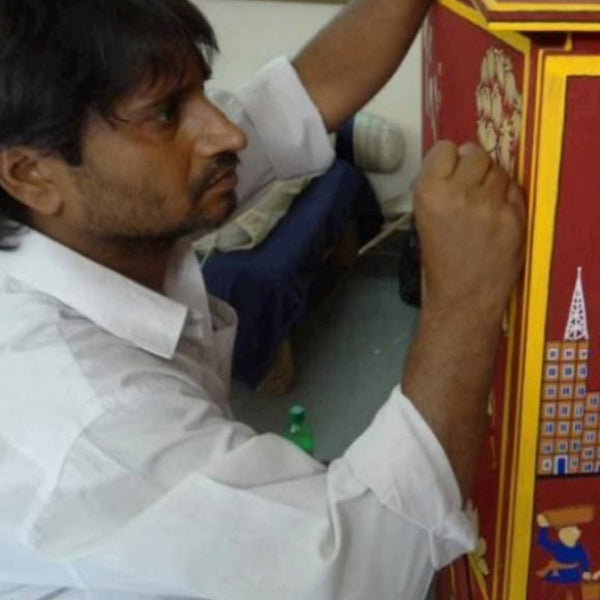Kavad
Art
Kavad art is a traditional form of storytelling through painted wooden shrines, originating from Rajasthan, India. These portable shrines, known as Kavads, are intricately painted and used by storytellers, known as Kavadia Bhats, to narrate mythological tales, folklore, and family histories. Each panel of the Kavad unfolds like a book, revealing different segments of the story as it opens. This art form combines visual art, oral tradition, and craftsmanship, creating a unique medium that preserves and communicates cultural narratives.
Kavad art primarily depicts themes from Hindu mythology, such as the epics of the Ramayana and Mahabharata, the stories of Krishna, and other religious narratives. It also includes folk tales, local legends, and genealogies of patrons. The style of Kavad art is characterized by its vivid colors, detailed illustrations, and narrative sequences that unfold as the Kavad opens. The paintings are stylized yet expressive, capturing the essence of the characters and scenes with a sense of movement and drama.
History
The history of Kavad art dates back several centuries, with its roots deeply embedded in the storytelling traditions of Rajasthan. Originally, the Kavadias, or storytellers, traveled from village to village, using these portable shrines to narrate stories of gods, heroes, and ancestors. The craft was typically passed down through generations within specific artisan communities, such as the Suthar community in Mewar, who specialized in making Kavads. Over time, the art evolved to include various religious and cultural tales, reflecting the rich oral traditions of the region.
Legend
According to legend, the Kavad derives its name from the term "Kavadh," which refers to a sacred pilgrimage. It is believed that the first Kavad was crafted by the divine architect Vishwakarma, who is also considered the patron god of craftsmen. The Kavads were meant to serve as mobile temples, allowing worshippers to carry their deities with them, thus making pilgrimages more accessible to those who could not travel to distant holy sites.
Material and Method
Kavads are traditionally made from lightweight wood, such as mango or neem, which is carved and assembled into a box-like structure with multiple panels and doors. The outer surfaces and inner panels are then meticulously painted with natural pigments using fine brushes. The vibrant colors often include reds, blues, yellows, and greens, with gold accents for embellishment. The painting style is detailed and narrative, focusing on clear, expressive illustrations that help convey the story. The making of a Kavad involves both carpentry and painting skills, showcasing the artisanal expertise of the craftsmen.
Significance
Kavad art holds significant cultural and spiritual value as it serves as a medium for preserving and passing down traditional stories and family histories. It is not just an art form but a storytelling tool that fosters a deep connection between the past and present. By combining visual and oral traditions, Kavad art plays a crucial role in sustaining the cultural heritage of Rajasthan. Additionally, it offers insights into the community's social and religious values, making it an important artifact of Indian folk culture. In contemporary times, efforts are being made to revive and promote Kavad art, ensuring its survival as a cherished cultural legacy.
FAQS
Are Kavads customizable or made to order?
Yes, MeMeraki offers customization options for Kavad art. You can request specific themes, stories, or even family genealogies to be included. Please contact us for details on custom orders, including timelines and pricing.
Do you offer international shipping?
Yes, we offer international shipping for our Kavad art pieces. Shipping costs and delivery times will vary depending on the destination. Please check our shipping policy or contact us for specific details.
How can I be sure of the authenticity of the Kavad art?
We work directly with artisans and craft communities to ensure the authenticity of each Kavad.
![]() Get Upto 10% OFF on purchase of this product.
Get Upto 10% OFF on purchase of this product.
![]() Get upto 10% OFF on Live Workshops when sign up for 2 or more workshops.
Get upto 10% OFF on Live Workshops when sign up for 2 or more workshops.
![]() Get 10% OFF coupon code for Art Kits signing up for Masterclass or Live Workshop.
Get 10% OFF coupon code for Art Kits signing up for Masterclass or Live Workshop.
![]() Earn upto 2,499 Points on purchase of this product.
Earn upto 2,499 Points on purchase of this product.






